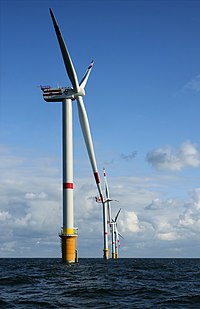
Photo from wikipedia
Ice accumulation on mechanical structures pose series of safety challenges in daily life. Therefore, it is important to detect the presence of ice and subsequently remove it, thereby hindering its… Click to show full abstract
Ice accumulation on mechanical structures pose series of safety challenges in daily life. Therefore, it is important to detect the presence of ice and subsequently remove it, thereby hindering its accumulation. We demonstrate an electrode design which can function concurrently as an ice detection and de-icing system. A dielectric coated interdigitated device was fabricated. Ice was generated using a Peltier cooler. By measuring the impedance change of the device with frequency under different conditions (dry and wet), ice was detected. Extent of ice formation can be estimated from the impedance values. Using the same interdigitated electrode device, de-icing was also established by applying a high frequency (50 kHz) and high voltage (200 $\text{V}_{\mathrm {rms}}$ ) AC signal. The output power of the system was calculated using an equivalent circuit model which also showed that the de-icing system delivers negligible output power in the absence of ice making it energy efficient. For performing de-icing on curved structures, the technique was demonstrated using flexible substrates where interdigitated electrodes were printed on flex polyamide substrates. [2019-0254]
Journal Title: Journal of Microelectromechanical Systems
Year Published: 2020
Link to full text (if available)
Share on Social Media: Sign Up to like & get
recommendations!